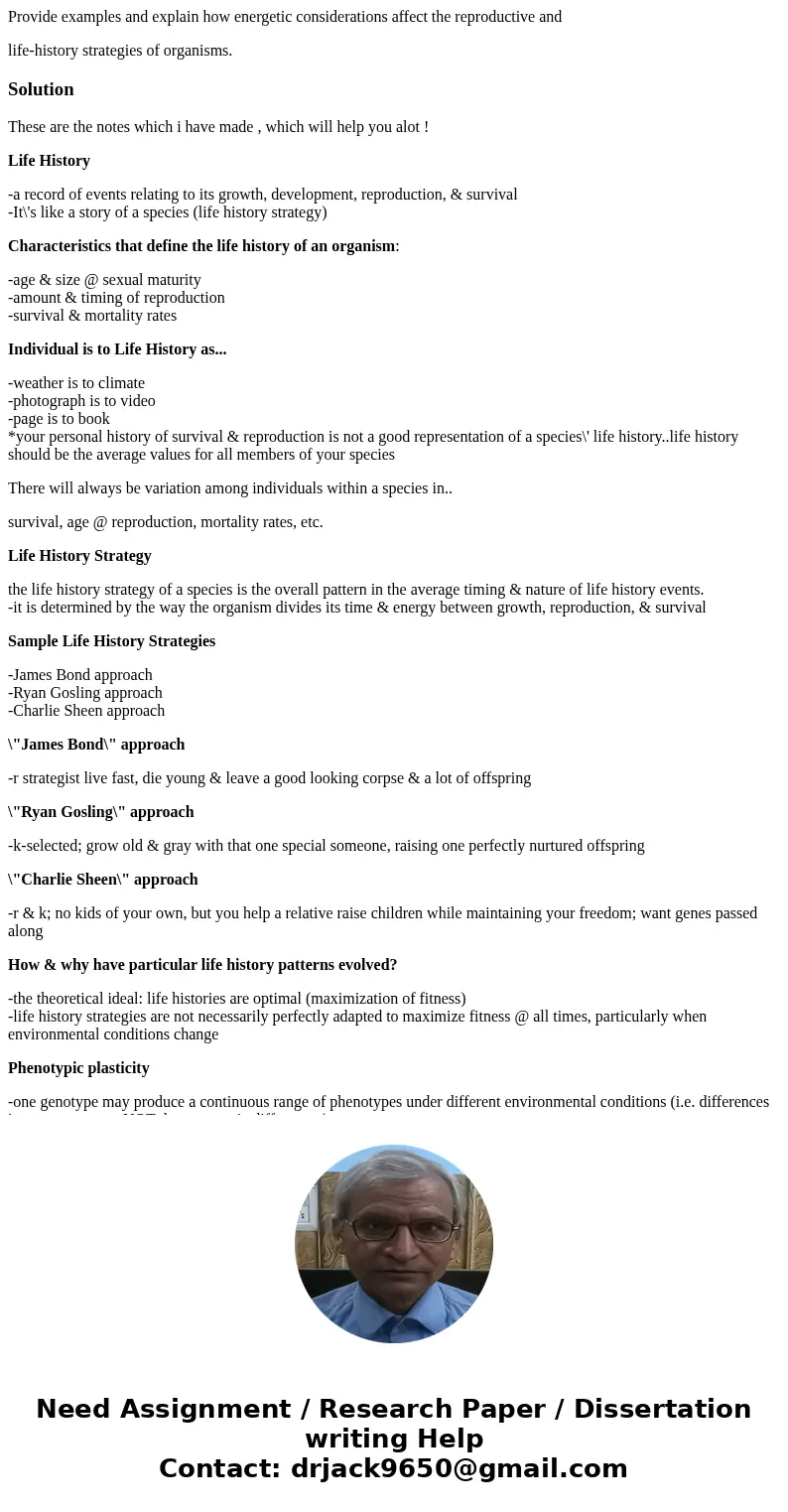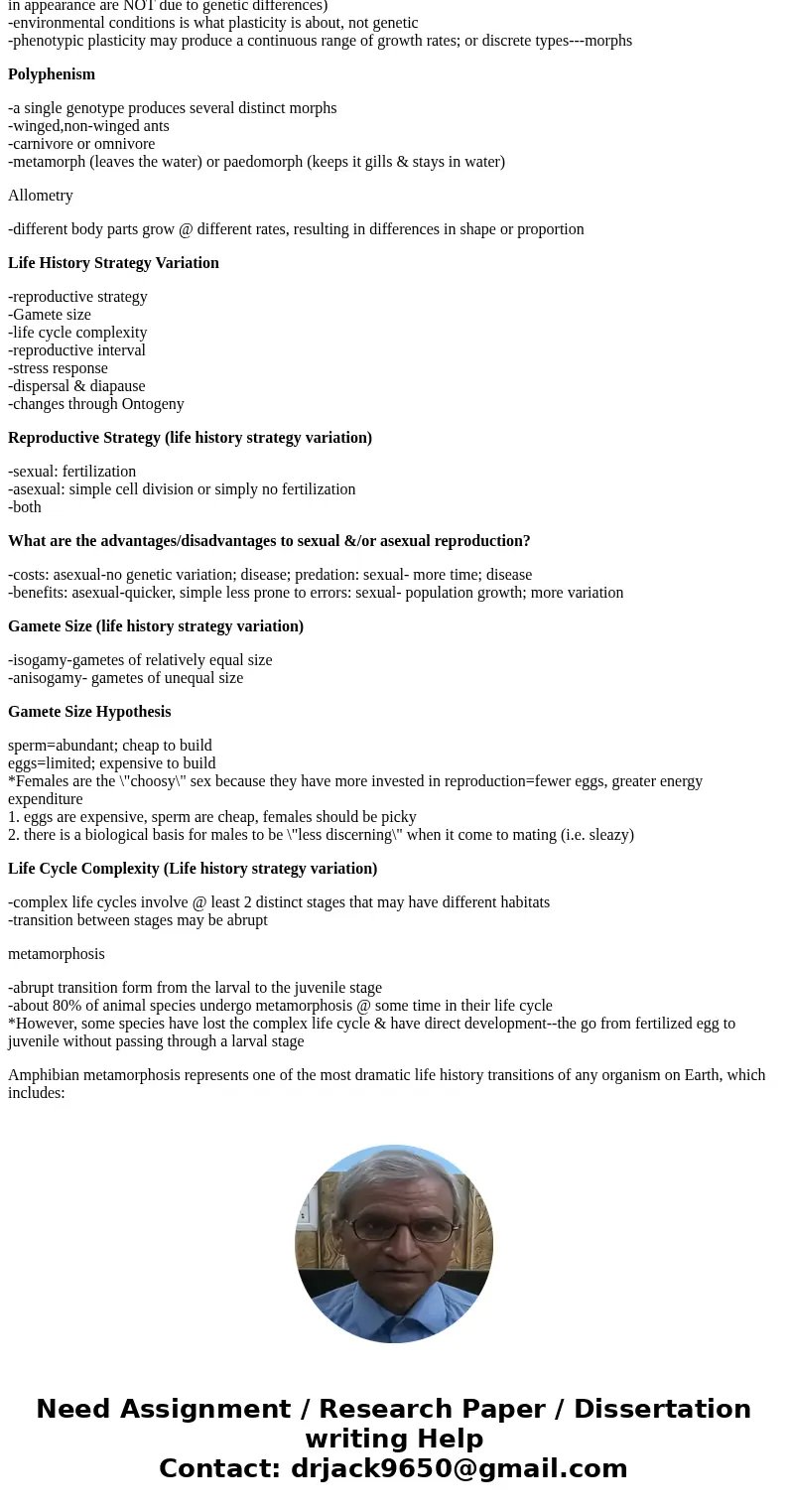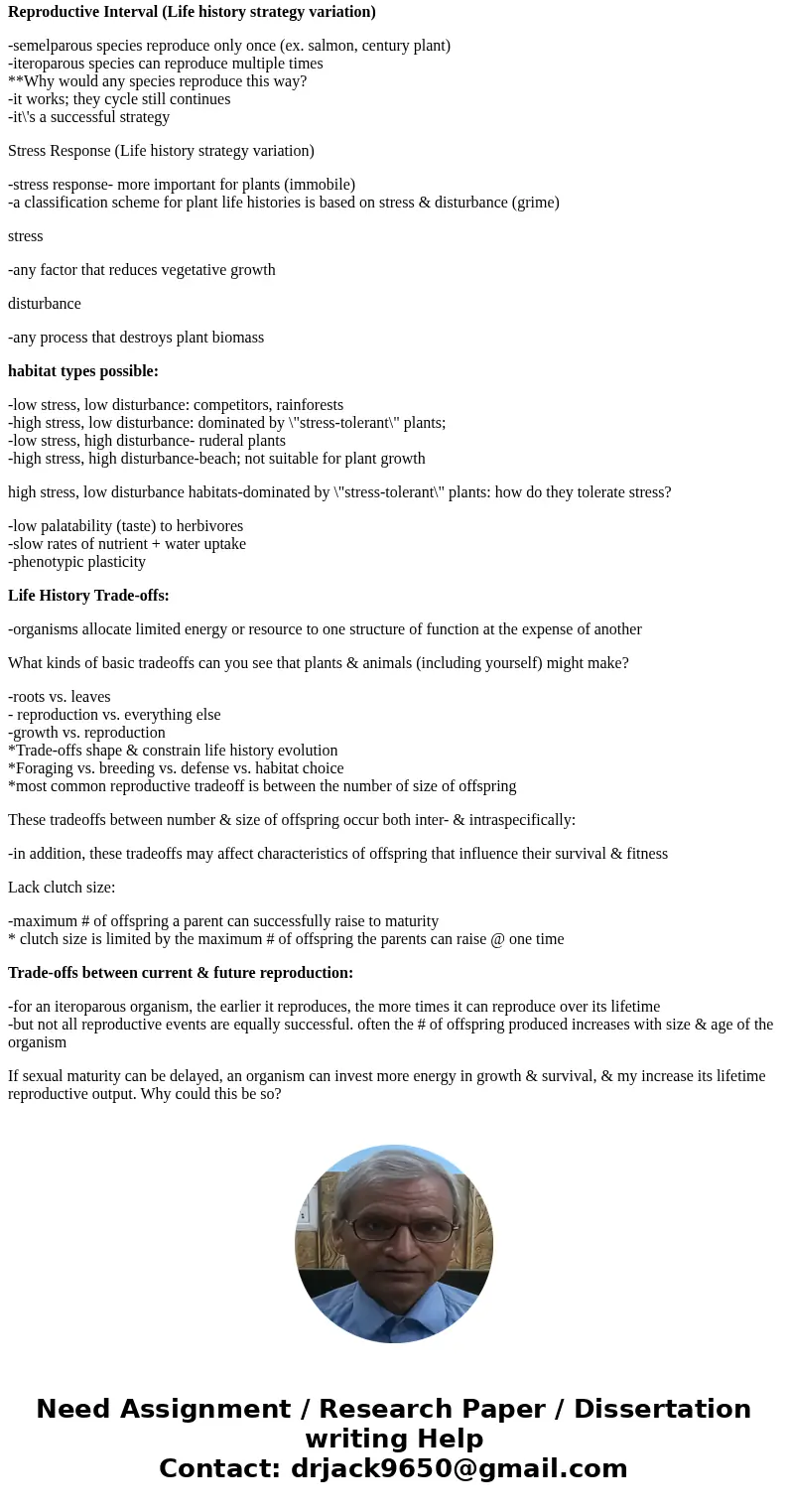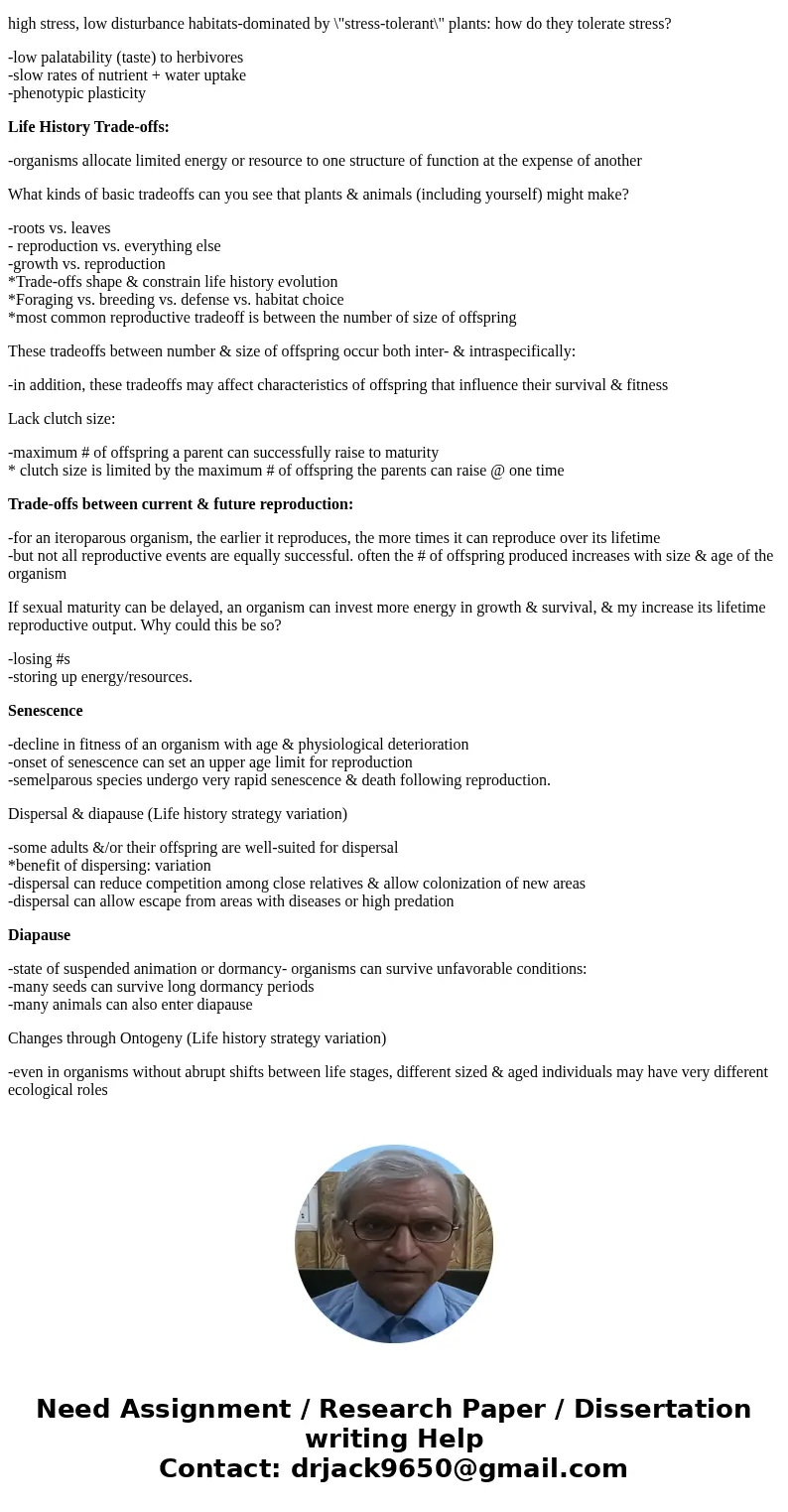Provide examples and explain how energetic considerations af
Provide examples and explain how energetic considerations affect the reproductive and
life-history strategies of organisms.
Solution
These are the notes which i have made , which will help you alot !
Life History
-a record of events relating to its growth, development, reproduction, & survival
-It\'s like a story of a species (life history strategy)
Characteristics that define the life history of an organism:
-age & size @ sexual maturity
-amount & timing of reproduction
-survival & mortality rates
Individual is to Life History as...
-weather is to climate
-photograph is to video
-page is to book
*your personal history of survival & reproduction is not a good representation of a species\' life history..life history should be the average values for all members of your species
There will always be variation among individuals within a species in..
survival, age @ reproduction, mortality rates, etc.
Life History Strategy
the life history strategy of a species is the overall pattern in the average timing & nature of life history events.
-it is determined by the way the organism divides its time & energy between growth, reproduction, & survival
Sample Life History Strategies
-James Bond approach
-Ryan Gosling approach
-Charlie Sheen approach
\"James Bond\" approach
-r strategist live fast, die young & leave a good looking corpse & a lot of offspring
\"Ryan Gosling\" approach
-k-selected; grow old & gray with that one special someone, raising one perfectly nurtured offspring
\"Charlie Sheen\" approach
-r & k; no kids of your own, but you help a relative raise children while maintaining your freedom; want genes passed along
How & why have particular life history patterns evolved?
-the theoretical ideal: life histories are optimal (maximization of fitness)
-life history strategies are not necessarily perfectly adapted to maximize fitness @ all times, particularly when environmental conditions change
Phenotypic plasticity
-one genotype may produce a continuous range of phenotypes under different environmental conditions (i.e. differences in appearance are NOT due to genetic differences)
-environmental conditions is what plasticity is about, not genetic
-phenotypic plasticity may produce a continuous range of growth rates; or discrete types---morphs
Polyphenism
-a single genotype produces several distinct morphs
-winged,non-winged ants
-carnivore or omnivore
-metamorph (leaves the water) or paedomorph (keeps it gills & stays in water)
Allometry
-different body parts grow @ different rates, resulting in differences in shape or proportion
Life History Strategy Variation
-reproductive strategy
-Gamete size
-life cycle complexity
-reproductive interval
-stress response
-dispersal & diapause
-changes through Ontogeny
Reproductive Strategy (life history strategy variation)
-sexual: fertilization
-asexual: simple cell division or simply no fertilization
-both
What are the advantages/disadvantages to sexual &/or asexual reproduction?
-costs: asexual-no genetic variation; disease; predation: sexual- more time; disease
-benefits: asexual-quicker, simple less prone to errors: sexual- population growth; more variation
Gamete Size (life history strategy variation)
-isogamy-gametes of relatively equal size
-anisogamy- gametes of unequal size
Gamete Size Hypothesis
sperm=abundant; cheap to build
eggs=limited; expensive to build
*Females are the \"choosy\" sex because they have more invested in reproduction=fewer eggs, greater energy expenditure
1. eggs are expensive, sperm are cheap, females should be picky
2. there is a biological basis for males to be \"less discerning\" when it come to mating (i.e. sleazy)
Life Cycle Complexity (Life history strategy variation)
-complex life cycles involve @ least 2 distinct stages that may have different habitats
-transition between stages may be abrupt
metamorphosis
-abrupt transition form from the larval to the juvenile stage
-about 80% of animal species undergo metamorphosis @ some time in their life cycle
*However, some species have lost the complex life cycle & have direct development--the go from fertilized egg to juvenile without passing through a larval stage
Amphibian metamorphosis represents one of the most dramatic life history transitions of any organism on Earth, which includes:
Reproductive Interval (Life history strategy variation)
-semelparous species reproduce only once (ex. salmon, century plant)
-iteroparous species can reproduce multiple times
**Why would any species reproduce this way?
-it works; they cycle still continues
-it\'s a successful strategy
Stress Response (Life history strategy variation)
-stress response- more important for plants (immobile)
-a classification scheme for plant life histories is based on stress & disturbance (grime)
stress
-any factor that reduces vegetative growth
disturbance
-any process that destroys plant biomass
habitat types possible:
-low stress, low disturbance: competitors, rainforests
-high stress, low disturbance: dominated by \"stress-tolerant\" plants;
-low stress, high disturbance- ruderal plants
-high stress, high disturbance-beach; not suitable for plant growth
high stress, low disturbance habitats-dominated by \"stress-tolerant\" plants: how do they tolerate stress?
-low palatability (taste) to herbivores
-slow rates of nutrient + water uptake
-phenotypic plasticity
Life History Trade-offs:
-organisms allocate limited energy or resource to one structure of function at the expense of another
What kinds of basic tradeoffs can you see that plants & animals (including yourself) might make?
-roots vs. leaves
- reproduction vs. everything else
-growth vs. reproduction
*Trade-offs shape & constrain life history evolution
*Foraging vs. breeding vs. defense vs. habitat choice
*most common reproductive tradeoff is between the number of size of offspring
These tradeoffs between number & size of offspring occur both inter- & intraspecifically:
-in addition, these tradeoffs may affect characteristics of offspring that influence their survival & fitness
Lack clutch size:
-maximum # of offspring a parent can successfully raise to maturity
* clutch size is limited by the maximum # of offspring the parents can raise @ one time
Trade-offs between current & future reproduction:
-for an iteroparous organism, the earlier it reproduces, the more times it can reproduce over its lifetime
-but not all reproductive events are equally successful. often the # of offspring produced increases with size & age of the organism
If sexual maturity can be delayed, an organism can invest more energy in growth & survival, & my increase its lifetime reproductive output. Why could this be so?
-losing #s
-storing up energy/resources.
Senescence
-decline in fitness of an organism with age & physiological deterioration
-onset of senescence can set an upper age limit for reproduction
-semelparous species undergo very rapid senescence & death following reproduction.
Dispersal & diapause (Life history strategy variation)
-some adults &/or their offspring are well-suited for dispersal
*benefit of dispersing: variation
-dispersal can reduce competition among close relatives & allow colonization of new areas
-dispersal can allow escape from areas with diseases or high predation
Diapause
-state of suspended animation or dormancy- organisms can survive unfavorable conditions:
-many seeds can survive long dormancy periods
-many animals can also enter diapause
Changes through Ontogeny (Life history strategy variation)
-even in organisms without abrupt shifts between life stages, different sized & aged individuals may have very different ecological roles




 Homework Sourse
Homework Sourse